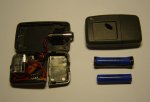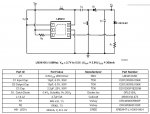IgorT
0
- Joined
- Oct 24, 2007
- Messages
- 4,177
- Points
- 0
When I was building my first laser, I bought a very small, good looking enclosure for it. Unfortunately, that meant I didn't have enough place for 6 Ni-MH batteries, to use the LM317 driver, so I had to leave current regulation out of the equation...
Since the internal resistance of the LD drops, as it heats up, this means the current will go up, if voltage stays the same. A driver would drop the voltage a little in this case, but I didn't have this luxury. So to keep my laser safe, I had to set the current lower, than I could with a real driver. This way, as it would heat up, the current still wouldn't increase over the maximum.
But this isn't the only drawback of "direct drive". As the battery discharges, it drops in voltage, so the output power is smaller, every time I power it on.
But I want my lasers small and powerful at the same time. So I decided to try with a boost circuit, which can turn a low voltage into a higher one. We discussed this in another thread: http://www.laserpointerforums.com/forums/YaBB.pl?num=1194375801/0
I tried a MAX765 and a MAX1674 circuit, which can make between 3 and 5.5V out of only one or two Ni-MH cells.
After testing these ICs, the results were very discouraging. The efficiency was very low, and the output wasn't constant at all. Besides, they can't regulate the current.
Then Woop mentioned a special SEPIC converter, which can regulate the current from a voltage higher or lower, than the output, the LM3410. Datasheet here: http://cache.national.com/ds/LM/LM3410.pdf - Design example 6
Several of us made our own PCBs and built this circuit, and I finally got the results I was waiting for!
This circuit can regulate the current from an input voltage between 2.7 – 5.5V, which makes it perfect for driving a laser from only one Li-Po cells, or even two Ni-MH cells with a simple modification. The current is adjustable with a resistor and the same circuit could be used to power any laser diode.. For low currents, the resistor could even be replaced with a trim pot. (blue ray readers)
I got an efficiency between 70 and 74.5%, which is almost twice the efficiency of the LM317 and means, that the laser would work from one Li-Po around 72% as long, as it would from two with the 317! With two Ni-MHs it would still work for around 70% as long as it would with six Ni-MHs on the 317.
The efficiency could get better with a professionally designed PCB and better components, but I am very happy with it, as it is.
I tested it on several different laser diodes and other loads and it works great. There were some concerns about current ripple, but with some advice from Phenol I managed to get the ripple so low, that it was hardly measurable, when I tested it with my electronics engineer today.
I'm gonna use this circuit with all my future lasers, and now that I got AAA size Li-Pos from DX, I can finally convert my poor "direct drive" laser to current regulation in that same tiny enclosure.
I had an old laser pointer (my first laser ever) that took two AAA cells, and had less than 1mW of power. It was dead for 8 years now. But this circuit allowed me to revive it, and at almost 200 times as much power!
Here's the picture of the old pointer with the new circuit next to the AixiZ module...
Since the internal resistance of the LD drops, as it heats up, this means the current will go up, if voltage stays the same. A driver would drop the voltage a little in this case, but I didn't have this luxury. So to keep my laser safe, I had to set the current lower, than I could with a real driver. This way, as it would heat up, the current still wouldn't increase over the maximum.
But this isn't the only drawback of "direct drive". As the battery discharges, it drops in voltage, so the output power is smaller, every time I power it on.
But I want my lasers small and powerful at the same time. So I decided to try with a boost circuit, which can turn a low voltage into a higher one. We discussed this in another thread: http://www.laserpointerforums.com/forums/YaBB.pl?num=1194375801/0
I tried a MAX765 and a MAX1674 circuit, which can make between 3 and 5.5V out of only one or two Ni-MH cells.
After testing these ICs, the results were very discouraging. The efficiency was very low, and the output wasn't constant at all. Besides, they can't regulate the current.
Then Woop mentioned a special SEPIC converter, which can regulate the current from a voltage higher or lower, than the output, the LM3410. Datasheet here: http://cache.national.com/ds/LM/LM3410.pdf - Design example 6
Several of us made our own PCBs and built this circuit, and I finally got the results I was waiting for!
This circuit can regulate the current from an input voltage between 2.7 – 5.5V, which makes it perfect for driving a laser from only one Li-Po cells, or even two Ni-MH cells with a simple modification. The current is adjustable with a resistor and the same circuit could be used to power any laser diode.. For low currents, the resistor could even be replaced with a trim pot. (blue ray readers)
I got an efficiency between 70 and 74.5%, which is almost twice the efficiency of the LM317 and means, that the laser would work from one Li-Po around 72% as long, as it would from two with the 317! With two Ni-MHs it would still work for around 70% as long as it would with six Ni-MHs on the 317.
The efficiency could get better with a professionally designed PCB and better components, but I am very happy with it, as it is.
I tested it on several different laser diodes and other loads and it works great. There were some concerns about current ripple, but with some advice from Phenol I managed to get the ripple so low, that it was hardly measurable, when I tested it with my electronics engineer today.
I'm gonna use this circuit with all my future lasers, and now that I got AAA size Li-Pos from DX, I can finally convert my poor "direct drive" laser to current regulation in that same tiny enclosure.
I had an old laser pointer (my first laser ever) that took two AAA cells, and had less than 1mW of power. It was dead for 8 years now. But this circuit allowed me to revive it, and at almost 200 times as much power!
Here's the picture of the old pointer with the new circuit next to the AixiZ module...










